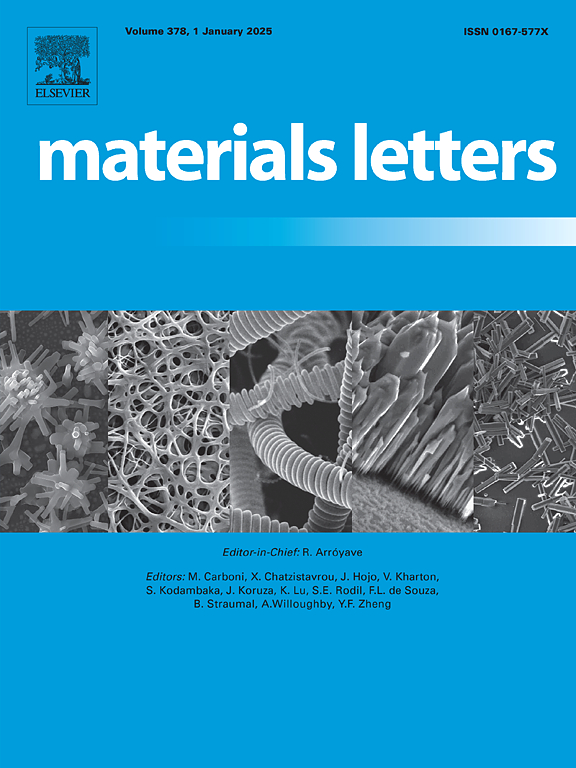将 Bi2S3 纳米花融入 TiO2 纳米棒以提高光电化学水分离性能
IF 2.7
4区 材料科学
Q3 MATERIALS SCIENCE, MULTIDISCIPLINARY
引用次数: 0
摘要
本文通过在 TiO2 纳米棒表面负载 Bi2S3 纳米材料,制备了 TiO2/Bi2S3 复合光阳极,以促进电荷载流子的分离和转移。通过控制前驱体的浓度,Bi2S3 的形态从纳米片状变为纳米花状,再变为纳米棒状。得益于三维结构的优势,用 Bi2S3 装饰的 TiO2 实现了更高的电荷载流子传输。此外,TiO2 和 Bi2S3 之间构建的 II 型异质结促进了光生电子和空穴的分离。在结构调制和异质结构建的协同作用下,TiO2/Bi2S3 复合光阳极获得了 0.25 mA/cm2 的最佳光电流密度,是原始 TiO2 的 5 倍。本文章由计算机程序翻译,如有差异,请以英文原文为准。

Integration of Bi2S3 nanoflowers into TiO2 nanorods for enhanced photoelectrochemical water splitting performance
Herein, TiO2/Bi2S3 composite photoanode was prepared by loading Bi2S3 nanomaterials on the surface of TiO2 nanorods to promote the separation and transfer of charge carriers. By controlling the concentration of precursors, the morphology of Bi2S3 was modulated from nanosheets to nanoflowers then to nanorods. Benefited from the advantaged three-dimensional structure, TiO2 decorated with Bi2S3 achieved the elevated charge carrier transport. Moreover, the constructed type II heterojunction between TiO2 and Bi2S3 facilitated the separation of photogenerated electrons and holes. With the synergistic effect of structure modulation and heterojunction construction, TiO2/Bi2S3 composite photoanode obtained the optimal photocurrent density of 0.25 mA/cm2, which is 5 times that of pristine TiO2.
求助全文
通过发布文献求助,成功后即可免费获取论文全文。
去求助
来源期刊

Materials Letters
工程技术-材料科学:综合
CiteScore
5.60
自引率
3.30%
发文量
1948
审稿时长
50 days
期刊介绍:
Materials Letters has an open access mirror journal Materials Letters: X, sharing the same aims and scope, editorial team, submission system and rigorous peer review.
Materials Letters is dedicated to publishing novel, cutting edge reports of broad interest to the materials community. The journal provides a forum for materials scientists and engineers, physicists, and chemists to rapidly communicate on the most important topics in the field of materials.
Contributions include, but are not limited to, a variety of topics such as:
• Materials - Metals and alloys, amorphous solids, ceramics, composites, polymers, semiconductors
• Applications - Structural, opto-electronic, magnetic, medical, MEMS, sensors, smart
• Characterization - Analytical, microscopy, scanning probes, nanoscopic, optical, electrical, magnetic, acoustic, spectroscopic, diffraction
• Novel Materials - Micro and nanostructures (nanowires, nanotubes, nanoparticles), nanocomposites, thin films, superlattices, quantum dots.
• Processing - Crystal growth, thin film processing, sol-gel processing, mechanical processing, assembly, nanocrystalline processing.
• Properties - Mechanical, magnetic, optical, electrical, ferroelectric, thermal, interfacial, transport, thermodynamic
• Synthesis - Quenching, solid state, solidification, solution synthesis, vapor deposition, high pressure, explosive
 求助内容:
求助内容: 应助结果提醒方式:
应助结果提醒方式:


